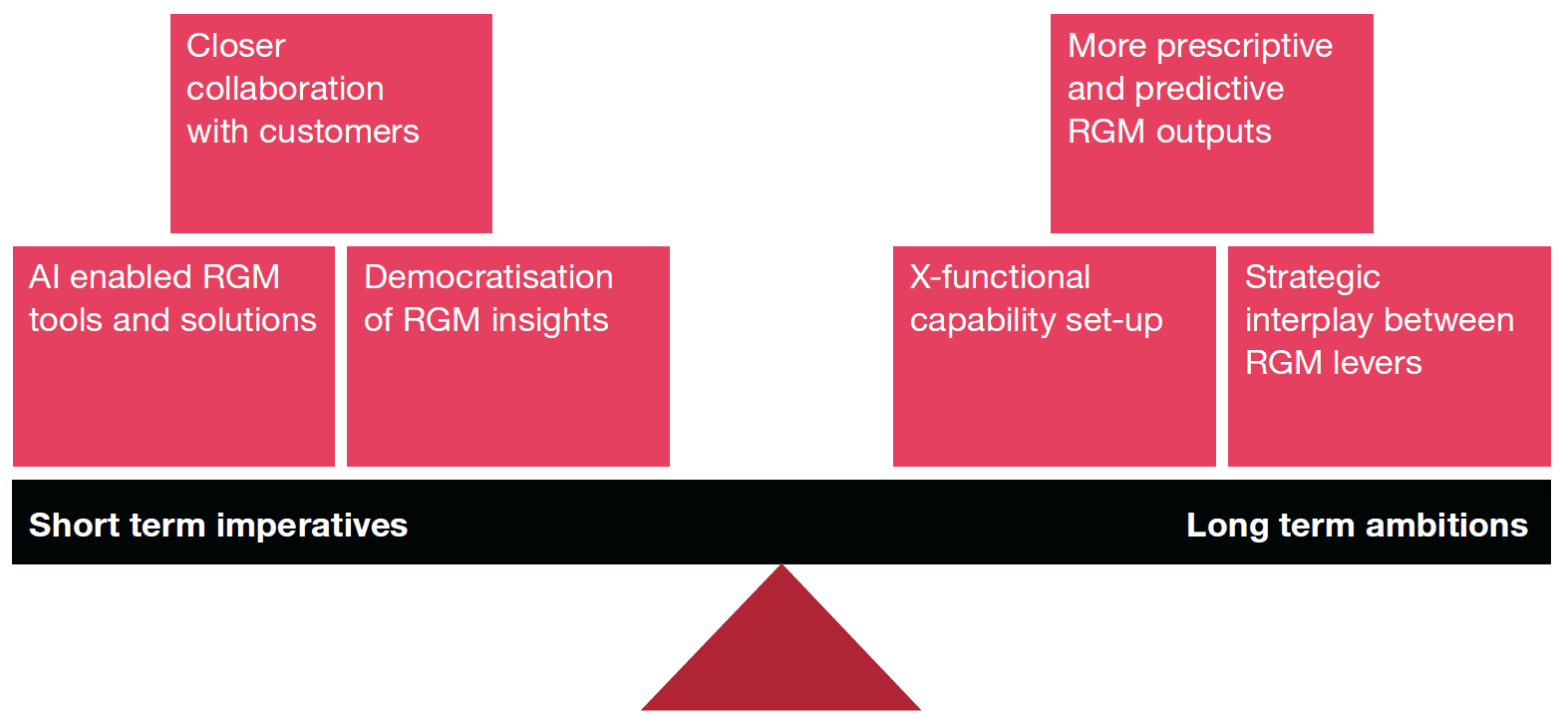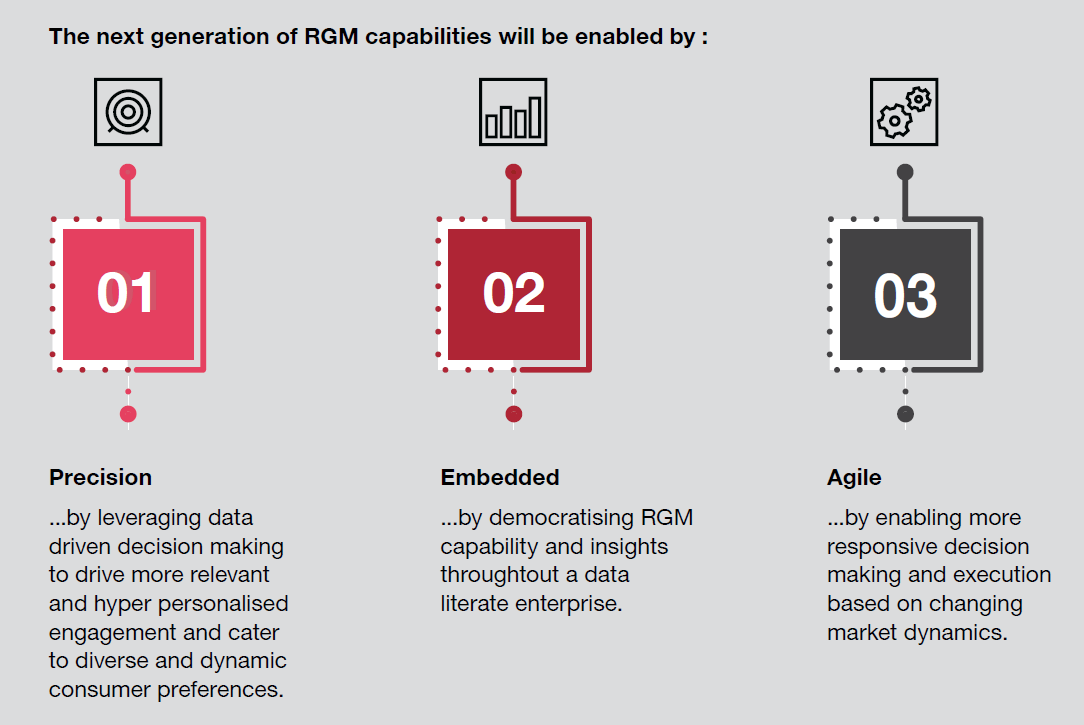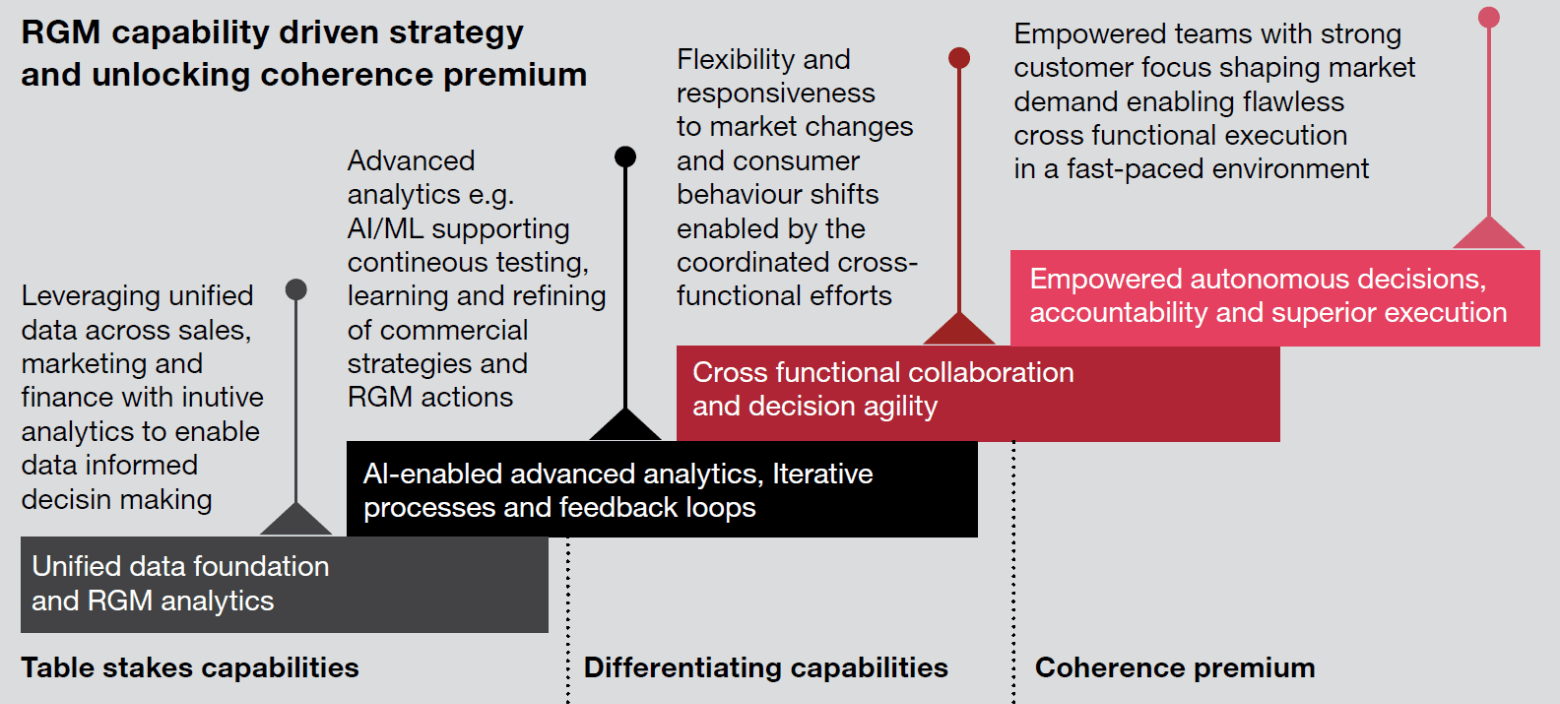By Mugdha Khare, Miles Preston and Luke Cross
The authors would like to express their gratitude to CPG leaders interviewed for their insights and Haris Nadeem, Natalia Antropova, Xindi Li, Juan Horos, Rithika Lakhwani and Egbert Ngabirano for their support in this research.
As consumer preferences shift and market dynamics evolve, Revenue Growth Management (RGM) becomes more critical than ever for Consumer Packaged Goods (CPG) organisations. We foresee a world where data-driven decision-making, collaboration, and agility converge to revolutionise revenue growth management in the CPG sector. But with challenges abound, how can CPG companies navigate the complexities and unlock their true growth potential? Join us on a journey to discover the untapped potential of RGM and how it can propel your business forward in an ever-changing landscape.
CPG Outlook for 2024 and beyond
Persistent inflationary pressures have resulted in Consumer Packaged Goods (CPG) relying on pricing actions for continued revenue growth. In the last year, most CPGs have reduced prices to provide impetus to category volumes with mixed results[1]. With prices remaining high and consumers looking to spend less[2] growth in the CPG sector is going to be a closely fought battle on retail store shelves.
In 2024 and beyond, CPG companies will need to find growth across their P&L through a mix of revenue growth levers. Holistic Revenue Growth Management (RGM) will take centre stage as reducing inflation limits the price-led growth, declining volumes and challenging trade negotiations further squeeze margins.
At CAGNY 2024, two thirds of consumer product companies indicated that revenue growth management remained a priority for them. The key focus areas are envisioned in price-pack architecture to drive range optimisation as well as premiumisation through close links with marketing. Taken together, the focus on volume and premiumisation highlights that for long term value CPGs need to rethink how their RGM function is designed and connected with the rest of the enterprise.
Fast moving technological disruptions such as GenerativeAI (GenAI) have created opportunities for CPGs to evolve their RGM capabilities and make them better suited to deliver the commercial outcomes. In this article, we look at how RGM needs to evolve to serve the CPGs of the future.
3 out of 4
consumer products RGM leaders expect trade terms negotiations to be very or extremely challenging this year
Strategy& Research, RGM 2024
Next generation of RGM capability
Our research highlights the following as key challenges faced by RGM function leads:
Which have a determining influence on the short term imperatives and long term ambitions for RGM capabilities across CPG organisations:

“The goal is to leverage technology to do the heavy lifting, driving continuous improvement in data harmonisation and quality, which in turn through intuitive automated reporting and visualisation enables sales and RGM teams to collaborate with richer, deeper insights, challenging the status quo and optimising investment decision making”
A closer look at these ambitions reveals the three themes that are defining the new approach for revenue growth management. RGM is increasingly seen as a critical enabler of commercial processes. Hence, an evolved RGM operating model to address the above
ambitions, needs to be more precise, more embedded and more agile with strong links across functions such as innovation, marketing, integrated business planning, sales and finance.

Enabling the next generation
Precision
Precision in RGM involves leveraging multiple disparate data sets to develop and execute targeted revenue actions while being confident in their outcomes. The key challenges include making optimal decisions across five levers (price, pack, mix, promotions, and trade terms) and accurately measuring the impact of these decisions. Traditional methods relying on historical data often fall short due to market complexity and variability, consumer behaviour, and competitive actions.
To enable precision, companies need to integrate traditional data sources with new ones, such as loyalty card data, social media data, web analytics, and geospatial data. An integrated approach provides granular insights into consumer behaviour enabling precise
segmentation and tailored RGM tactics. Advanced analytics, simulation tools and AI can then quantify the causal effects on key performance indicators and help optimise actions across various scenarios and uncertainties.
In Practice:
A leading Europe-based beverage producer leveraged advanced geospatial analytics to strategically deploy sales resources, resulting in a 15% growth in volume sold through managed independent stores.
“History shows that even the most advanced analytics can fail to deliver results. The key missing link is often the seamless integration of analytics, insights, and processes. Without embedding precision RGM into business processes, even groundbreaking analytics ends up in the junkyard”
80%
of RGM leaders believe they do not have the capability to implement precision RGM, mainly driven by data issues, lack of resources, and skill shortage
Embedded
Embedding and democratising RGM capabilities and insights enables a long term growth focus by proactively shaping market conditions as well as upskilling the frontline commercial teams across sales, marketing and finance. Building an embedded RGM capability involves a phased transformation within CPG organisations, affecting processes, governance, incentives, and toolsets.
This transformation will need to:
- Empower commercial teams with insights from combined data sets used in precision RGM.
- Provide intuitive tools for data analysis, with GenAI productivity assistants aiding in data synthesis, insight generation, and crafting compelling selling stories.
- Shift accountability to sales for their annual plans and aligning sales incentives with profitable revenue growth.
- Ensure effective category-level governance to balance account objectives with overall category growth.
In Practice:
A prominent European drinks manufacturer used predictive analytics to monitor key performance indicators, enabling tailored strategies that reduced churn and targeted high-potential prospects, resulting in a 5% annual growth in outlets.
“The relationships and how RGM is wired into the sales team as well as GM in the organisation are crucial for decision making, which allows them to be more risk-taking and more flexible and fast in making decisions which requires accepting a higher degree of risk with limited information. The RGM function can not work without the support and inputs from all the other functions, and they need to understand RGM and understand how their pieces fit into the puzzle.”
Agile
Agile RGM prioritises flexibility, responsiveness, and iterative processes to enhance revenue growth. It capitalises on data analytics, cross-functional collaboration, and continuous improvement to swiftly adapt to market changes and optimise revenue strategies.
Enhancing agility in decision making will require that CPG organisations enable iterative processes for continuous testing and refinement, data-driven decision-making leveraging real-time analytics, cross-functional collaboration across sales, marketing, finance,
and other departments, and a customer-centric approach that focuses on delivering value and understanding customer needs.
In Practice:
A leading multinational consumer products organization established a Centre of Excellence to drive agile, data-driven retail execution innovations, resulting in increased shopper conversion rates across the omnichannel path to purchase.

Finding your strategic fit
In our research, we found that there is not a single view of RGM capabilities that would work for all CPG organisations. It is not advisable for all CPGs to either get a SWAT team of RGM experts nor to attempt devolution of RGM insights and decision making onto other commercial functions.
When determining your unique blend of precision and agility you should consider the following 3 contextual elements:
Category
- Highly commoditised categories with typically lower margins requires high precision and agility, focusing more on data and operational efficiency.
- Differentiated products with higher margins requires focusing more on customer- centric strategies and responsiveness.
Competition
- Fragmented market requires the highest levels of precision and agility due to intense competition and diverse customer needs.
- A monopoly market requires lower levels of precision and agility in competitive terms but still needs to maintain a strong focus on customer satisfaction and adaptability.
Channel
- Converging channels, e-commerce and omnichannel operations demand the highest levels due to their dynamic nature and reliance on real-time data.
- Brick-and-mortar and B2B channels tend to have more stable environments and longer sales cycles, leading to slightly lower immediacy in adjustments.
Taken together, these will inform the strategic choices needed to achieve the right degree of precision, agility and embeddedness in your RGM capability. These choices come with significant operating model implications for CPG organisations. It is important for CPG organisations to find the right balance of standardisation and accountability when determining the RGM operating model that will support the end-to-end commercial cycle.
Decentralised decision-making typically enhances agility due to the ability to respond quickly and tailor strategies to local conditions. However, it also requires precise, localised insights to ensure these decisions are well-informed.
Centralised decision-making, while benefiting from standardised processes and holistic insights, often sacrifices some degree of agility due to slower, more hierarchical decision-making processes.
Similarly, the assignment of accountability for commercial outcomes to either the Sales or Revenue Growth Management (RGM) function will significantly impact focus areas required in the operating model. Sales accountability emphasises customer insights, immediate responsiveness, and tactical adjustments, whereas RGM accountability will need to focus on data-driven strategy development, adaptive revenue management, and cross-functional coordination.
The evolved RGM operating model represents a transformative approach that can propel companies into a future of sustainable growth and competitive resilience. It is important to realise that this next horizon of RGM capability is not merely a set of new tools or processes, but a comprehensive shift in how companies plan, execute, and measure their success. It requires a deep-seated cultural change, a reimagining of team structures, and a commitment to leveraging data and advanced technology like never before.
CPG organisations embarking on this journey will need to understand the pivotal role of technology and data in driving business performance while ensuring their capabilities work together to realise the coherence premium from a capability system. Addressing the dual fronted problem of data literacy and data explainability will be critical to success by providing executable insights and making the data easy to interpret/understand for ‘non data’ people. This blueprint serves as an essential guide for leaders aiming to optimise their RGM function to foster growth, innovation and collaboration.
“You need to invest in the execution/sales capability first and then invest in the technology/analytical capability to accelerate it. The biggest driver of your success and driving the profitable growth are people with right Business Acumen to be able to marry the practical matters and RGM planning, and execute the plan you built. A key question.. is how can you drive a robust system/enterprise system that drives RGM processes, an equivalent of Workday that embeds into business routines.”

RGM capabilities that fit their business and market context can position organisations to be more resilient, better equipped to handle market uncertainties, and more effective in driving sustainable revenue growth. The journey towards this evolved capability is complex and multifaceted, but the rewards are clear: a competitive edge in a rapidly changing business environment and a robust financial foundation for the future. Get in touch to find how PwC Strategy& can accelerate your journey to a precise, agile and embedded RGM capability!





